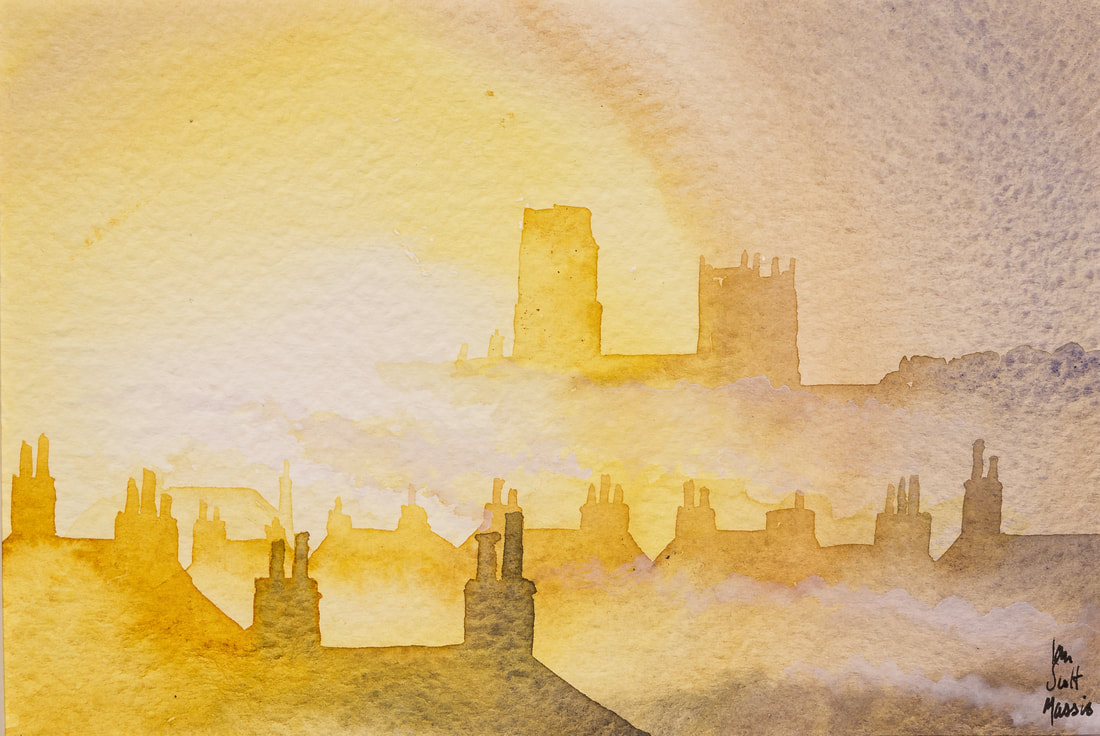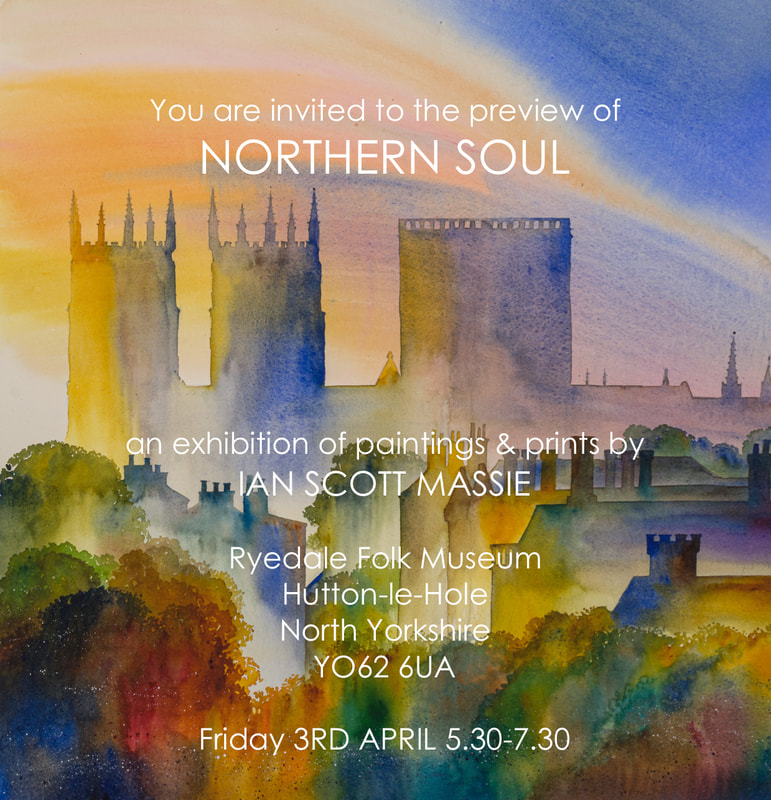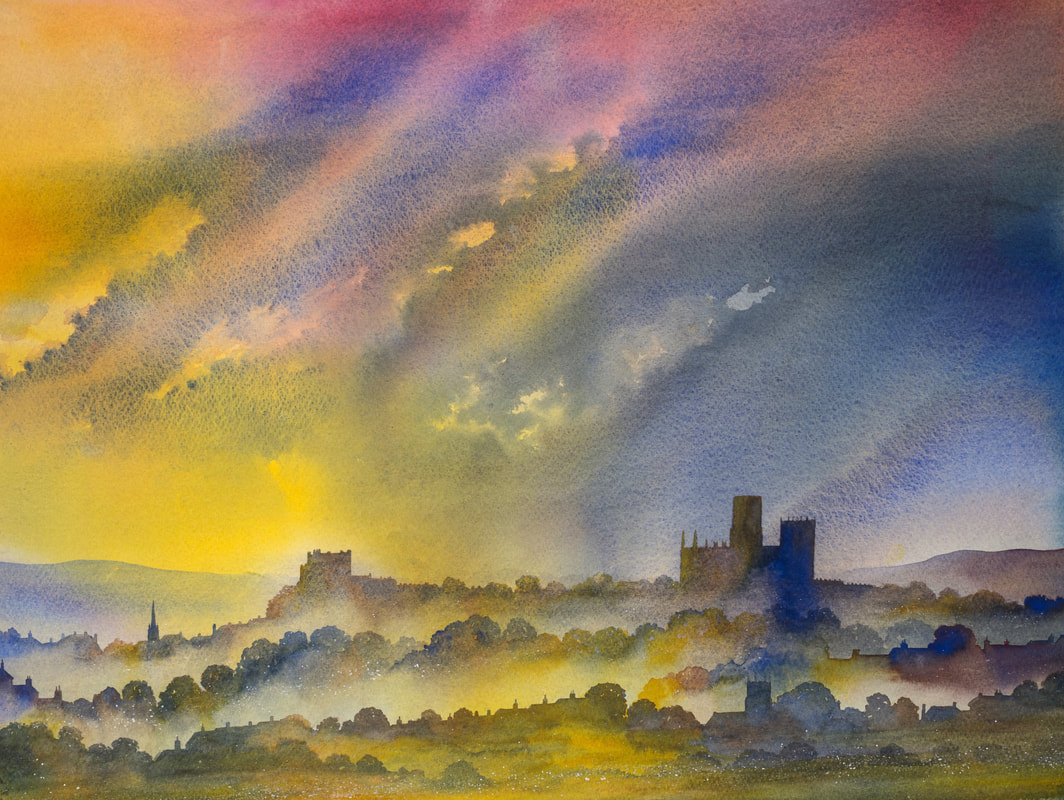|
Durham, Morning Light, watercolour This is where my life in the North really started. I had passed through Durham several times as a child, but always asleep - swaying gently in my bunk on the sleeper train from Kings Cross to Aberdeen. I have a dream-like image in my head of the long train steaming up the East of England under the summer moon, rattling through a litany of slumbering cities on its way to the wake-up call of the Forth Bridge crossing. I knew nothing about Durham when I arrived: nothing about coal seams, outside toilets, working men’s clubs, the pitmatic dialect, the Prince Bishops, the Northumbrian saints, panhaggerty and Category D villages. I didn’t know that John Ruskin had declared the view from the station the eighth wonder of the world when, transfixed, I gazed at the miraculous, misty vision of the cathedral and castle rising on their rock above the city from a green cloud of trees. The streets curved, flowing around the meander of the River Wear and, beyond, the blue hills disappeared into the distance. From my hilltop college I could walk down narrow footpaths, over a fairytale bridge and into the shadowed heart of the cathedral in a few glorious minutes. In the pubs and cafes and clubs I got to know musicians and artists. The lilting cadences of their accents, the unshakeable sureness of their shared culture and the warmth with which they included me in their lives left an indelible impression on me. I began to lose what Southern reserve I had and learn empathy and trust. Beyond its medieval roots Durham was built on and paid for by coal. North Road crosses Framwellgate Bridge and climbs to the Market Place. A right turn takes you higher, between towering facades, to Palace Green where at one end stands the cathedral, and, at the other, the castle. This is Durham’s display of stately grandeur and it’s amazing. But if you turn left you cross the 12th century Elvet Bridge. For one day in the year this street is bursting with brass bands and banners and marching feet as a socialist celebration - the Big Meeting (the Durham Miners’ Gala) - takes over the town. The heritage of hard work, humour, political fire and music of the Durham coalfield comes into the ancient city in a blaze of glory. And there, in a nutshell, you have an essential feature of Durham’s character: inequality. It’s the gulf between the easy privilege of the church and university and the legacy of hard labour, between reserve and verve, between the arrogance of assumed authority and the refusal to submit to it. There is a good humoured echo here of a theme which runs through the North - revolt against the South. In 1069 the people of the Northumbria - the kingdom recently subsumed into England - rose up against their newly installed conquerors in a bid to recreate an independent North. With their ancient allies of Scotland and Denmark they attacked the garrison of Durham Castle and slaughtered it, moving on to besiege York. They failed, but the spark of revolution was never to be completely extinguished. From "Northern Soul" by Ian Scott Massie The book is available from Masham Gallery http://www.mashamgallery.co.uk/store/p379/Northern_Soul.html The exhibition of Northern Soul opens at Ryedale Folk Museum, Hutton le Hole, North Yorkshire with a preview on April 3rd.
1 Comment
Durham Cathedral from the Viaduct, watercolour In 2016 I had the idea of creating an exhibition about my life in the North of England. The idea grew into a series of paintings and prints and then into a book. I found that delving into my past, trying to see how I first saw the places I discovered in the North, was an amazing source of inspiration.
The exhibition began touring in 2019 having its debut at Cannon Hall near Barnsley and then moving to Masham Gallery. This year it's going to Ryedale Folk Museum, Farfield Mill and Sunny Banks Mills - all places which relate to different aspects of the North and my time there. This year I'd thought I'd accompany the exhibition with an occasional blog including extracts from the book and some of the pictures. Here's the first instalment. The year is 1973... "I came to the North of England in September 1973. At the age of twenty I had come to learn how to be a music teacher, at a college in Durham. I was deeply unhappy. I was going to a strange city a long way from home, my lovely father was dying of cancer, I was about to study for a career that I was in no way sure I wanted to do and, since my exam results had been appalling, I had great doubts about my ability to stay the course. Little did I know that the North would make me. I would grow up there, discover talents for teaching and making art that I never suspected, discover places and music and stories that I would love for the rest of my life, and find happiness. Along the way one question would occasionally surface: What makes the North the North? It isn’t simply that old cliche: a hard-working alternative to a soft and lazy South, and yet it’s a hard question to answer. It is an alternative of sorts - an alternative to the dreamy chocolate-box portrayal of England that exists only in the imagination. Perhaps, if we’re honest, its the truth of England, where all things are seen clearly: the incomparable beauty of the landscape, the harsh ugliness left by industry, the great wealth of the aristocracy, the miserable housing of the poor, the civic pride of the mill towns and a people as likely to be mobilised by political oratory as by a comedian with a ukulele. The North is a place made up of a multitude of races, each with their own deep pool of stories which combine to make a shared way of life. Mining, the Potato Famine, the textile industry, persecution, war and politics all brought different people to the North. The list goes on. So I’ve approached the Northern Soul as though it were a jigsaw puzzle: examining the pieces I’ve come across over the years for what they can tell me. I’ve got some bits of the edge and some promising parts of the middle but I’d be lying if I said I was close to completing it. There are parts of the North I know only slightly and others I know like the back of my hand, and I’ll plead guilty now to favouring some places over others because that’s just the way it is. So this book is at once the log of a long, as yet unfinished, journey, and a love letter to the North of England. It’s about the places I’ve known and painted, and what part they play in this complex, careworn, mountainous, multifaceted, wave-tossed, warm-welcoming, windblown, freezing, friendly, tough spirited, tender hearted, rusty, rebellious, ruinous, green, golden, chilled- out, challenging, deep-rooted, dale-scattered, subtle, smoky, special land. " From "Northern Soul" by Ian Scott Massie The book is available from Masham Gallery http://www.mashamgallery.co.uk/store/p379/Northern_Soul.html The exhibition opens at Ryedale Folk Museum, Hutton le Hole with a preview on April 3rd. |
Archives
June 2024
|


